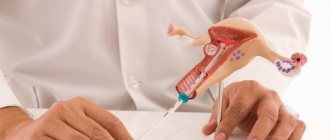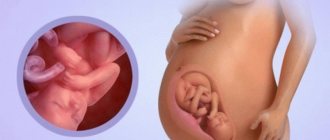This research method is highly informative and safe for the patient. However, like any endoscopic procedure, colonoscopy has a number of contraindications. Let's take a closer look at how to minimize the risk of complications, when it is better to postpone the examination to a later date, and in what cases a colonoscopy should not be done.
There are absolute and relative contraindications to colonoscopy. Their list and brief description are presented below.
Medical research during menstruation
Regular physiological changes that occur in the female body bring not only discomfort. Internal organs, circulatory, endocrine, and nervous systems work differently at this time, with a greater load. Various chronic disorders worsen, fluid retention occurs, more blood flows to the pelvic area, and tissues swell.
The general health of women during menstrual periods is also not in the best condition. Many experience moderate or severe pain, heaviness, and a feeling of tension in the abdominal cavity. It is no coincidence that doctors of all profiles do not recommend undergoing medical examinations or diagnostic examinations during menstruation. The exception is a few specific manipulations.
In the case of intestinal endoscopy when menstruation begins, problems may be associated with:
- with copious discharge from the genital tract;
- increased contractions and swelling of the intestinal walls;
- insufficient effect of anesthetic drugs;
- increased bleeding in places of damage to the mucous membranes;
- risk of infection.
In cases where a woman suffers from algomenorrhea, has difficulty withstanding painful sensations or is in a state of psychological stress, there can be no talk of any additional procedures. It is not recommended to remove teeth, perform hysteroscopy, or perform any invasive interventions.
Usually doctors answer positively when asked whether it is possible to do a colonoscopy during menstruation. Critical days are not included in the list of contraindications for this type of diagnosis. However, whenever possible, they try to save women from unnecessary difficulties, discomfort and reduce the risk of possible complications. If the appointed date for video colonoscopy coincides with the period of critical days, it is postponed several days ago.
Complications after colonoscopy
Women who are scheduled for a colonoscopy and the dates fall on menstrual days are interested in a number of questions related to subsequent complications if the procedure is not postponed.
There are no definite answers; troubles occur regardless of the period of passage. The main insurance in this situation will be:
- physician experience;
- patient behavior during colonoscopy;
- absence of hidden force majeure factors;
- positive influence of external factors: no tsunamis, earthquakes, radio-emitting disasters, armed clashes and other events associated with the influence of the human factor.
The doctor is selected using the “word of mouth” method; it is not difficult to tune in correctly to the procedure if you try hard, but what about the third point? What to consider as such factors:
- A bleeding polyp suddenly discovered during an examination can be removed or cauterized.
- Unexpected equipment failure.
- The peculiar structure of intestinal loops often causes microtrauma.
Increased bleeding if the procedure was performed during menstruation. This is explained by the fact that the advancement of the hose and the injection of air into the loops of the intestine became a kind of massage for the surrounding internal organs and increased blood flow. The condition is not critical; after a certain time, the amount of blood released returns to normal.
Why is a colonoscopy performed?
A colonoscopy is a procedure in which a flexible, thin tube is inserted through the anus to examine the entire large intestine. At the end of the device there is a cold light source and a miniature camera. The image from it is transmitted to the monitor. During the examination, the doctor has the opportunity to examine the intestinal walls in detail, identify all existing neoplasms and defects of the mucous membrane: areas of erosion, polypous growths, diverticula, ulcerative lesions. With its help, gastrointestinal diseases are diagnosed in the early stages, and suspicions of the development of oncological tumors are confirmed or dispelled.
In terms of information content, colonoscopy is superior to radiography and sigmoidoscopy. In addition to diagnostic purposes, it is capable of performing therapeutic functions:
- remove polyps up to 2 mm in size;
- remove foreign bodies and fecal stones that have gotten inside;
- prevent and stop intestinal bleeding;
- restore normal patency with a narrowed lumen between the walls;
- take puncture material for histological examination.
For patients, the advantage of colonoscopy over other types of endoscopic intestinal examinations is the absence of severe pain. In the process, only physical discomfort is likely.
Why is anesthesia needed for FCS?
Colonoscopy under anesthesia relieves the patient of the physical and psychological discomfort associated with the insertion and advancement of the colonoscope tube. He will not experience pain during a biopsy, if there is a need to take tissue samples for histological examination.
Anesthesia makes it possible to avoid the formation of fear of repeated FCS, so that the patient in the future will not avoid the recommended scheduled regular examinations. According to reviews, after a colonoscopy in a state of medicated sleep, there is no pain in the anus and in the abdomen.
The use of anesthesia also improves the quality of the examination. Moderate muscle relaxation in a sleeping patient and the absence of involuntary resistance on his part give the doctor the opportunity to carefully examine the folds of the mucosa in all parts of the large intestine.
Indications for testing
The need for the procedure is previously agreed upon with the patient. In cases where the diagnosis is aimed at establishing the cause of any chronic disorder, a routine examination is prescribed. In this case, choose a day when there is no likelihood of menstruation.
Colonoscopy during menstruation is prescribed if:
- a woman has signs of intestinal endometriosis: the functional tissue of the uterine cavity grows on the surface of adjacent organs;
- during critical days, several days before or after them, bleeding from the anus regularly occurs;
- the presence of small polyps and neoplasms: during menstruation, due to the flow of lymph and blood to the pelvic organs, all changes in the mucous membrane are more prominent.
An emergency bowel examination is necessary when health is in serious danger. Delay in such cases is unacceptable. Urgent indications:
- intestinal obstruction;
- acute inflammatory process;
- persistent constipation, unresponsive to medication;
- release of exudate;
- mechanical injury;
- control examination after surgery.
In some cases, colonoscopy is indicated as a surgical treatment.
How often should you have a colonoscopy?
According to modern clinical guidelines, indications for FCS include:
- Previously diagnosed chronic bowel diseases.
- The patient has a history of a polyp or other benign neoplasm in the gastrointestinal tract.
- Identification of indirect signs of a tumor according to other research methods (ultrasound, radiography, irrigoscopy, etc.).
- The patient develops symptoms suspicious of tumor growth. These include unstable stools, recurrent or chronic abdominal pain, persistent low-grade fever, detection of blood or mucus in the stool (outside the phase of acute diarrheal infectious syndrome), chronic treatment-resistant anemia (iron deficiency or B12 deficiency), persistent increase in ESR and a number of other signs.
- The patient has cancer risk factors, a hereditary history of gastrointestinal cancer. Currently, permanent residence in large cities and in areas of increased industrial pollution is considered as a predisposition to cancer, including colorectal localization.
Persons with chronic gastrointestinal pathology, previously diagnosed diverticulitis and intestinal polyposis are recommended to undergo fibrocolonoscopy at least once a year. The frequency of visits is determined by the doctor individually; in some cases, diagnostics are carried out every 6–8 months. People from the high-risk group aged 40–45 years are recommended to undergo FCS once every 2 years, and after 45 years – annually.
Contraindications to colonoscopy
Colon endoscopy is a relatively safe procedure, but in some cases it can cause additional harm to health. You will have to refuse it if:
- heart rhythm disturbances;
- decreased blood clotting;
- exacerbation of hemorrhoids;
- the presence of adhesions in the abdominal cavity;
- existing spasms and severe pain of unknown origin.
During menstruation, these conditions are most likely. The risk of damage to swollen internal hemorrhoids is especially high. As a result of accidental contact with vaginal discharge on the irritated mucosa, an infection may occur. Potential complications are very serious, therefore, despite the reasons for conducting the examination, it is better to postpone it to another period.
Preparing for the FCC
Preparing the patient for the study includes:
- Examination to exclude contraindications to anesthesia. It is necessary to donate blood for general and biochemical tests, do an ECG (with interpretation), if you have chronic diseases, consult a therapist, and if there are severe hormonal disorders, consult an endocrinologist.
- Following a certain diet aimed at reducing gas formation in the intestines and reducing the volume of intestinal contents. For 3–5 days before the procedure, fruits, vegetables, seeds, nuts, most cereals, legumes, and sweets (sweets, chocolate, baked goods) are excluded from the diet. Consumption of milk and fatty fermented milk products is undesirable. Alcohol, juices with pulp, and strong broths are prohibited.
- Avoid eating for 16–20 hours before your scheduled examination. You can drink water and prescribed medications no later than 3-4 hours before the procedure.
- Limit smoking; it is advisable to temporarily quit smoking a few hours before anesthesia.
- Cleansing the large intestine to the state of transparent, slightly colored and liquid stool. Previously, repeated enema was used for this; now drug preparation for the procedure is preferred. ICLINIC doctors recommend using the drug Moviprep for this; a detailed dosage regimen can be clarified with the clinic’s specialists.
Preparing for a colonoscopy is the most important stage of the study. Properly performed bowel cleansing significantly increases the degree of visualization of the upper parts of the colon, expands the diagnostic capabilities of the technique and increases the reliability of the results. And following the rules of preparation for anesthesia makes it easier to tolerate and eliminates the risk of complications.
How is the procedure performed?
A few days before the colonoscopy, a preparatory diet is prescribed. In 2-3 days, and in case of chronic disorders of the gastrointestinal tract - in a week, it is necessary to exclude from the diet fried meat, semi-finished products, pastry, sweets, raw fruits, coarse fiber and other foods that increase fermentation. It is recommended to eat stewed vegetables, boiled eggs, cereals, and dried white bread.
You should take a laxative prescribed by your doctor 12–24 hours in advance. Complete bowel cleansing ends with an enema. The procedure is performed on an empty stomach.
- Before a colonoscopy during menstruation, the patient is recommended to lie on her left side, pulling her legs towards her stomach or stand in a knee-elbow position.
- The doctor applies an antiseptic to the anal area and uses local, sedative or general anesthesia. An anesthetic gel based on lidocaine is most often used. The drug is used to lubricate the anus and the tip of the probe.
- An air mixture is introduced into the intestines to ensure passage, and the device is inserted inside. The specialist guides the advancement of the colonoscope inside the abdominal cavity by palpation until the camera at its end reaches the cecum.
- At the end of the session, gases are removed from the intestinal cavity through a special channel of the device, and the device is removed.
The duration of the entire procedure is no more than 30 minutes. After completion, the patient comes to her senses after anesthesia. In the first hours, severe discomfort is likely: bloating, rumbling, cramps. To eliminate symptoms, it is recommended to take activated charcoal and drink water.
The examination is carried out on an outpatient basis, except when the patient is in a hospital. After a few hours you are allowed to return to your normal activities.
Within 1–2 days after colonoscopy, flatulence, minor bleeding with or without stool, and spastic contractions of the intestinal walls are possible. This reaction is considered normal, and against the background of menstruation it is almost inevitable.
If symptoms persist for more than three days, intensify, or are accompanied by weakness, diarrhea, heaviness in the abdomen, fever, massive bleeding or cutting pain, you should immediately consult your doctor.
Colonoscopy of the intestine
Colonoscopy is a method of diagnosing the intestines using a flexible probe with a high-resolution video camera. The image with a magnification of up to 10 times visualizes the condition of the tissues, the presence of formations, inflammation, and sources of bleeding. During the examination of the intestines, the doctor can take biomaterial for histological examination, stop bleeding, and remove polyps.
Indications for examination
- Age over 55 years. According to statistics, colorectal oncology accounts for 10-11% of the total number of diagnosed cancer cases. The largest number of cases are in the age group over 55 years. The danger of localizing tumors in the intestines is that in the first stages there may be no symptoms, or the manifestations may be uncharacteristic. To diagnose pathology at an early stage, it is recommended to do a colonoscopy of the intestines annually.
- Pain in the intestines. If there is pain, the causes of which have not been established during other examinations, the patient is indicated for a colonoscopy. Pain sensations can be pulling, sharp or spasmodic.
- Regular constipation and bowel irregularities. Excessive pushing and hard stools can lead to intestinal injury and the formation of foci of inflammation. In addition, constipation can be a consequence of other pathologies that also require diagnosis and treatment.
- Presence of blood in stool. With intense bleeding, clearly visible veins appear. This may be a symptom of bleeding in the sigmoid or rectum. The presence of blood in the stool can also be detected by analysis.
- The presence of pus and mucus in the stool. This sign indicates an infectious process - an abscess, a disintegrating tumor, tuberculosis or acute inflammation of an ulcer. Such symptoms require immediate medical attention.
- Regular stool disorders of a non-infectious nature. This is one of the manifestations of disorders of the small intestine. In this case, beneficial substances from food are not absorbed, malabsorption develops, and metabolism is disrupted.
- Weight loss with normal nutrition and constant physical activity. If body weight decreases for no apparent reason, it is necessary to examine the digestive system, including a colonoscopy.
- Anemia and increased erythrocyte sedimentation rate (ESR) that do not go away with drug therapy. These are signs of constant blood loss or pathologies of the hematopoietic system. Blood loss may be a sign of hidden bleeding, including in the intestines.
In addition, intestinal colonoscopy is indicated for those who have a history of polyps or the appearance of neoplasms of different locations. If among your relatives there are those who have suffered from intestinal oncology, it is recommended to conduct an examination once a year, regardless of age. In addition to routine research, the procedure can be prescribed for emergency indications:
- The presence of a foreign object in the intestine.
- Bleeding due to the formation of protrusions on the intestinal walls with their further rupture.
- Impaired patency, narrowing of the intestinal lumen.
During emergency colonoscopy, the examination is combined with treatment procedures. The doctor can provide first aid and plan further therapy.
Contraindications to colonoscopy
Despite the sensitivity of the procedure, colonoscopy is usually well tolerated by patients. But there are a number of conditions when the study is postponed or impossible to carry out:
- For acute respiratory diseases, infectious intestinal diseases, peritonitis, severe poor health.
- With exacerbation of chronic diseases of the cardiovascular system, decompensated endocrine diseases.
- For blood clotting disorders. If you are taking blood thinning medications, you must inform your doctor about this to assess the risks of the procedure.
- For chronic or acute diverticulitis, large hernias.
- For colitis, ulcerative lesions of the intestine in the acute stage, granulomatous inflammation of the gastrointestinal tract.
- With heavy bleeding, anal fissures, exacerbation of hemorrhoids.
- After intestinal surgery.
During pregnancy, the advisability of a colonoscopy is assessed individually based on the patient’s condition.
Important:
If the intestines are poorly cleansed, research becomes difficult. In this case, the doctor may interrupt the procedure and reschedule it for another day.
How is a colonoscopy performed?
For the examination, an endoscopic device is used, which allows the doctor to see the condition of the intestines and perform manipulations.
The endoscope consists of a flexible tube about 2 meters long. The tube is made of soft hypoallergenic material, which increases the safety of intestinal colonoscopy.
At the end of the tube there is a video camera, openings for the irrigation and instrumental channels, and illumination.
- The video camera has high resolution and light sensitivity, which allows you to get a clear image in low light conditions.
- Backlight improves video quality and helps you work with tools.
- An irrigation channel is needed to supply air. This facilitates the passage of the probe and, in some cases, allows the stenosis to be relieved.
- The instrumental channel is needed for inserting biopsy syringes, injection needles, wire loops, clips and other devices into the intestine.
During endoscopy, the doctor controls the probe using a control unit; the same unit allows manipulation of the intestine using instruments.
The image from the camera is sent to the monitor on an enlarged scale, which allows you to see even small formations (about 1 mm), foci of inflammation and other pathological processes.
During the procedure, the patient lies on the couch on his left side with his knees tucked. In this position, intestinal colonoscopy is performed as comfortably and informatively as possible.
The doctor treats the endoscope and the area around the anus with a disinfectant. To facilitate sliding, lubricant is applied to the distal end of the probe.
When the patient is ready, the doctor inserts the endoscope into the anus and begins to move along the intestines. Air is supplied from the irrigation channel to straighten the folds and facilitate the passage of the probe. In this case, the patient may feel bloating or a feeling of fullness. This is a normal reaction that accompanies the procedure.
The examination lasts about 30 minutes, which allows you to assess the condition of the rectum and large intestinal cavity. If medical procedures are required, a colonoscopy will take longer.
After completing the examination and treatment operations, the doctor carefully removes the endoscope. If general anesthesia was not used during the procedure, the patient can stand up immediately, but sudden movements should be avoided. A feeling of bloating and fullness in the intestines is acceptable.
If the colonoscopy was performed in a medicated sleep, the patient is woken up, his well-being is assessed and he is also allowed to get up.
No hospital stay is required; you can leave the clinic after the colonoscopy. The examination results can be provided in the form of a form filled out by a doctor and on electronic media with a video recording.
Treatment during colonoscopy
If pathologies are found during an examination of the intestines, some of them can be eliminated using the endoscopic method:
- Intestinal adenomas and polyps. Neoplasms that can develop into a malignant tumor. Usually their size does not exceed 1 cm. They can occur singly or form conglomerates. In addition to the likelihood of progression to oncology, the formations make it difficult to pass stool. If adenomas are injured when passing strong stools, then there is a risk of an inflammatory process. During colonoscopy, it is possible to remove small lesions using a loop clamp and a coagulation electrode.
- Bleeding. Injuries to intestinal tissue can become inflamed without treatment. During colonoscopy, bleeding can be controlled using electrocoagulation or the application of clips. It is also possible to treat angiodysplasia (vascular pathology) of the mucous membrane.
- Neoplasms larger than 1 cm. When a tumor of this size is detected, colonoscopy is combined with sampling for histological examination.
- Removing foreign objects. The manipulation clamp allows you to remove solid objects from the intestines.
Biopsy, removal of polyps and adenomas, coagulation of blood vessels are performed using local anesthesia or general anesthesia.
Use of anesthesia during colonoscopy
Typically, anesthesia or sedation is used during medical procedures, but in some cases they are also needed for colonoscopy:
- When the patient has a low pain threshold. To relieve discomfort, a topical anesthetic may be applied.
- If there is severe inflammation or adhesions, sharp pain may occur during the procedure. Depending on the situation, the doctor assesses the possibility of continuing the study under anesthesia.
- If the patient has mental disorders or uncontrolled movements, then clonoscopy is performed under general anesthesia.
- If a person feels uncomfortable, the procedure can also be performed in a dream.
Possible complications of colonoscopy
The procedure is considered safe and atraumatic. The study is well tolerated by most patients. After a colonoscopy you may experience:
- Bloating that goes away within a day.
- Minor discomfort in the anal area goes away after a few hours.
- If polyp resection or biopsy was performed, abdominal pain and fever within 38.0°C are acceptable. Symptoms should subside within 1-3 days.
Important:
Successful colonoscopy depends on the experience of the doctor. Incorrect technique or careless use of instruments may result in intestinal damage and bleeding.
Also, during the study, allergic reactions to anesthesia and other drugs may develop. To prevent such complications, the doctor collects anamnesis before performing a colonoscopy. If the patient has an allergy, this must be reported.
If after the examination the patient develops weakness, dizziness, decreased ability to concentrate, vomiting with blood or diarrhea, then you should seek help immediately. This may be a sign that the colonoscopy caused internal bleeding.
What does the examination show?
During a colonoscopy, the following intestinal pathologies can be diagnosed:
- Neoplasms. In the video you can differentiate polyps, adenomas, tumors at an early stage.
- Colitis. With this disease, the walls are ulcerated, blood may ooze from them, and pus may be released. Outside of exacerbation, the mucous membranes may be hyperemic, without a pronounced vascular pattern.
- Diverticulosis. This is a protrusion of the intestinal wall to the side with the formation of a cavity inside. Feces accumulate and stagnate in the cavity, and the tissue becomes thinner, even to the point of rupture. This pathology is not accurately determined by ultrasound, but colonoscopy makes it possible to diagnose and treat hernial elements.
- Adhesions and foreign bodies. The formation of adhesions and the entry of foreign bodies often provoke obstruction. Colonoscopy accurately determines the cause of the disorders.
- Tuberculosis. The disease can develop as a result of pulmonary tuberculosis. During a colonoscopy, the doctor will see tissue damage by specific granulomas.
- Ischemia. Circulatory disorders can occur due to vascular pathologies. In this case, the tissues do not receive nutrition, as a result of which necrotic processes develop and ulcers appear.
During the examination, other diseases may be detected. In some cases, after a colonoscopy, the patient is sent for additional diagnostics: ultrasound, CT, MRI, irrigoscopy and other studies.
Preparation for the procedure
The possibility of performing a colonoscopy and its informative content depends on the quality of preparation.
The main task is to clean the intestines so that solid contents do not interfere with the advancement of the probe and do not complicate the visualization of tissues. General preparation scheme:
- For 7-10 days, stop taking blood thinning drugs (unless otherwise agreed with the attending physician), drugs to increase hemoglobin levels, and activated charcoal.
- If a colonoscopy is performed under anesthesia, then 10 days before you need to take tests for syphilis, HIV, hepatitis B and C, and general blood and urine tests.
- 2-3 days before the colonoscopy, you need to switch to a diet that prevents the formation of toxins and gases. Legumes, nuts, fruits, raw vegetables, flour, carbonated drinks, and sweets are excluded. Also, you should not eat or drink foods and liquids with a red and purple color (beets, cherry nectar, etc.). The basis of nutrition in preparation for colonoscopy can be clear broths, jelly, light juices without pulp.
- During the entire preparation period, it is recommended to drink as much plain water as possible.
- The last meal before a colonoscopy is acceptable 20 hours before the examination.
Preparing for a colonoscopy includes taking laxatives. The night before (3-4 hours before bedtime) and in the morning 5 hours before the examination, it is necessary to cleanse the intestines using the drug Fortrans or analogues.
- 2 sachets of powder are dissolved in 2 liters of water, after which 200 ml of the drug is taken every 7-10 minutes.
- The effect of the drug will last for the next three hours. During this period, it is recommended to stay at home as frequent bowel movements will occur.
To improve the taste of the prepared solution, you can cool it for several hours and replace 100 ml of water with 100 ml of freshly squeezed lemon or orange juice.
After squeezing, the juice must be filtered so that the pulp does not get into the solution. During cleaning, it is recommended to drink plenty of fluids (water, water with lemon), the last intake of liquid is 2 hours before the examination.
You should choose loose, comfortable clothing that does not compress the abdominal area. It is not recommended to smoke on the eve and on the day of a colonoscopy, as nicotine causes spasms of blood vessels and makes them fragile, increasing the risk of complications such as bleeding.
If you have a history of chronic diseases, food allergies, preparation for a colonoscopy is agreed with your doctor. The discontinuation of medications taken, the use of microenemas, and replacement of the active ingredient in a laxative should also be discussed with a specialist.
Important:
proper preparation for colonoscopy will allow the endoscopist to examine the condition of the mucous membranes as thoroughly as possible and detect formations 1 mm in size. If cleaning is not done well enough, diagnosis becomes difficult.
Capsule examination or colonoscopy: what is the difference?
An alternative to colonoscopy is capsule diagnostics.
The mini-camera is built into a capsule that the patient swallows. As the capsule moves, it takes pictures and the data is transmitted to a receiver attached to the patient’s body. The capsule comes out naturally. The method does not require preliminary measures, is more comfortable from a psychological point of view and allows you to examine the entire gastrointestinal tract.
But a significant advantage of colonoscopy is the ability to linger on the desired areas for a more detailed study and carry out treatment. In addition, the cost of endoscopic diagnostics is significantly lower.
The main thing about colonoscopy
- Unlike radiation diagnostic methods, with colonoscopy it is possible to visually examine the condition of the mucous membranes and combine examination with treatment.
- The correctness of the results depends on the thoroughness of preparation. You need to take this stage seriously. Colonoscopy may be delayed due to stool accumulation in the intestines.
- The patient should be in a calm state. If psychological difficulties arise and the nervous condition does not go away, it is better to perform a colonoscopy under sedation.
The qualifications and experience of the endoscopist are of great importance. You need to undergo a colonoscopy in a clinic with a good reputation, high-quality modern equipment and a proven staff of doctors.
Doctors' opinion
Colonoscopy helps to accurately determine the nature of existing tumors in the large intestine, prevent the development of malignant tumors, ulcerative colitis and other serious diseases. This diagnostic method provides comprehensive information on a number of problems - where other measures are powerless.
After the procedure, you need to monitor your well-being. A sharp deterioration in physical condition or continuous bleeding may indicate injury to the intestinal wall. Sometimes the procedure can provoke the development of appendicitis or exacerbation of colitis.










